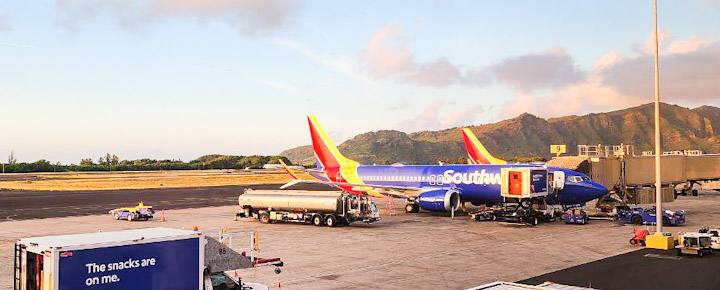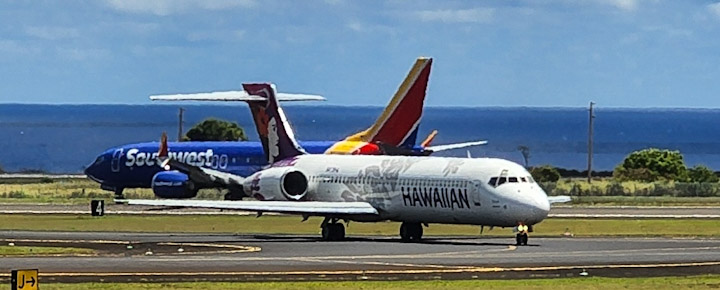Southwest Airlines has just joined forces with its arch-nemesis Hawaiian Airlines. They didn’t want to be left out of the Hawaii Seaglider Initiative (HSI), which also includes Alaska Airlines, United Airlines, and other prominent players. HSI is slated to be a alternative to interisland travel coming before the end of the decade. These sea gliders will go harbor to harbor (instead of airport to airport) and travel 30-60 feet above the ocean.
In a press release dated March 14, Seaglider “Announced the inclusion of Southwest Airlines as a corporate member… With this addition, HSI seeks to advance discussions on the integration of Seagliders as an affordable and sustainable transportation solution for Hawaii’s communities.”


Southwest Airlines, which first announced long-awaited plans for Hawaii flights in October 2017, actually began flying here in 2019. Inasmuch as they fly interisland, this is of particular interest to them, as it is Hawaiian. Seaglider said this is Southwest’s “First public engagement with battery-electric propulsion technology” as part of their environmental sustainability mission.


What’s up next at Hawaii Seaglider Initiative?
HSI will launch a series of discussion groups focusing on key aspects of its plans, including community, culture, infrastructure, resiliency, and more.
Seagliders are a groundbreaking, albeit controversial, mode of transportation.
Developed by REGENT, these vessels combine the speed of planes with boat-like affordability, offering an intriguing solution to reducing travel time and costs between islands. With plans for early deployment by mid-decade, Seagliders are poised to modernize Hawaii transportation while trying to align with the state’s environmental targets.
These unique vessels float on a stable hull above the water.
As the Seaglider starts to move outside of the harbor, they will transition onto “wave-tolerant” hydrofoils that feature minimal resistance. They then take to the air, flying as an aircraft at a very low altitude, 30 to 60 feet above the water.


In January, Gov. Green said that this “Interisland transportation network will provide a renewable transportation alternative that will help keep our communities connected, support our local businesses, and build a resilient economy for Hawaii.” The Hawaii DOT has also expressed its support for the project as a collaborative partner.
If all goes as planned, electric Seagliders will be a huge advancement in technology and transportation and represent potentially groundbreaking advancement in both. Traveling at a speed of up to 180 mph, they are set to decrease the cost and time to travel interisland compared with traditional flights currently offered by both Southwest and Hawaiian Airlines.
Many questions remain about safety and wildlife.
Safety in relation to Hawaii ocean conditions and protecting Hawaii wildlife is paramount to these ultimately being approved. Renewable energy, harbor infrastructure, climate, and environmental concerns will also need to be addressed.
Who are HSI partner airlines?
Airline partners to date include Alaska Airlines, Hawaiian Airlines, Japan Airlines, Mokulele Airlines, Southwest Airlines, and United Airlines. There are other non-airline partners as well.
Mokulele Airlines is set to be the first Seaglider operator.
They will commence with smaller 12-passenger Viceroy-model Seagliders “by the middle of the decade.” The larger Seagliders which will presumably be used by other airlines, are planned for deliveries at the end of the decade.
$30 tickets to Seaglide interisland?
One premise of Seaglider is affordability. Seaglider previously announced that “A route feasibility study estimates a one-way seaglider ticket from Oahu to Maui or Oahu to Kauai could cost $30.” Additional use as a Hawaii cargo barge alternative is also envisioned.
Your comments about Seaglider speak to issues it faces.
Some of your comments have been positive, while others have asked questions, and some are skeptical, at least at this point.
- “The Seaglider news is exciting. If it will be truly cheap to take one to other islands, that is wonderful. One could visit friends and family just for the day, and the fares would not put a big dent in one’s budget.”
- “As these things don’t even exist for testing yet, I can’t wait to see how they work in anything but the glass-smooth sea surface shown in their promotional videos. When the sea is rough, the air on top of it is quite unstable, and I suspect these things will be a sea sickness factory like nothing else.”
- “I can’t imagine how this will work. It’s 2024, and it Is the middle of the decade.”
- “There is no battery technology remotely mature for this.”
- “Will they be able to operate at night?”
- “Do they expect to be able to round trip from Oahu to the neighbor islands or will they have to build charging infrastructure at the docks, which don’t exist?”
- “And, oh, yeah. How’s that wind and solar coming that will charge them?”
- “I am excited for the technology and would really like to see a ferry type service between islands. Do have concerns about Environmental/Community impact (sea life, parking, transport, etc). Would really like to see a drive-on ferry system, but this is at least something…if it gets a green light.”
- “Haven’t we done enough to screw up the environment of the Hawaiian Islands? Please don’t do this!!”
- “Mokulele Airlines should not be an operator as they have not helped the locals with an affordable means of travel between Oahu, Maui, Molokai, and Lanai. Current round-trip fares average $220 per person. Additionally, schedules aren’t dependable, mostly due to mechanical breakdowns. Being the only public airlines to Molokai and Lanai (monopoly), they are able to charge whatever fares they choose. Passengers don’t have any alternatives. Aloha.”
- “Here we go again (remember the Hawaii Superferry’s failure to do an EIS). This BOH article points out that this new airline service is expected to begin in the next year or two. However, there is no indication that an adequate environmental impact statement has been prepared or is even being prepared. It will be necessary because there will be changes to the state’s harbors, among other potential environmental triggers. There will be concerns about parking for the air passengers, transportation facilities (taxi, rent-a-car) from the harbor to where people may want to go, interference with other harbor facilities, etc.”
- “What excites me is the technology. What concerns me is the effect it will have on Hawaiian sea life, in particular, breaching whales. If these seagliders “fly” at 30′-60′ above the water, there must be a concern about accidentally impacting breaching whales. Is this being addressed?”
- “The humpback whales in Hawaiian waters only grow up to 50 feet in length when fully grown. Which means they’re only breaching about half that length. So, no problem. Plus, whales are smart. They will hear that plane coming long before it poses a danger. I hope the airline charges extra for the whale-watching feature of the flight. Can’t wait to board one. I’ll be standing in line for the maiden flight. I hear it will be serving excellent snacks and selling nice memorabilia. I recommend the T-shirts.”
- “Wow! Great news”
- “Yes, zero emissions but charged by fossil fuel (primarily petroleum, some coal) powered electrical generation plants! The article also failed to inform the reader about how many trips could be made before requiring to recharge. Looks interesting, but I am skeptical. No regenerative braking to extend extend range.”
Please share your thoughts on Seaglider as an upcoming alternative to current interisland flights.






I just visited the Seaglider website… this idea appears to be conceptual, all of the images of the Seaglider they are proposing for interisland travel are renderings. From what I saw, there is nothing to back up their claims as far as range, performance, etc., they don’t even have a motor manufacturer identifed.
Also, I mentioned in another post that they appear to be relying on ground effect for efficiency, ground effect is consistent over a hard surface, like a runway, over water it is not nearly as consistent and sea conditions would affect any efficiency they are trying to take advantage of.
What surprises me is that there are partner airlines… I am however not surprised that the inept Gov is backing this.
Think the same things were said to the Wright Bros. over a century ago.
Not quite the same thing… this is basic aerodynamics, I think other pilots on here will make similar observations regarding ground effect over rough seas and the logistics of having low flying aircraft flying 180mph sharing the same airspace as catamarans/sailboats/wildlife.
The other issue is the technology most likely isn’t there yet, weight is the enemy of aircraft and electric batteries are heavy, also what would the charge time be between flights.
What scares me too is that they may not need to get faa approval, this will likely fall under maritime due to the type of vessel they are. Imagine flying 180 mph 30’ above the water, a wind gust hits you and a wing tip touches the water, bad news.
Very good and much needed service between islands. Cost effective for travelers will help increase travel and enhance options for travelers.